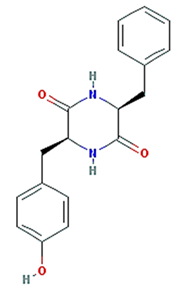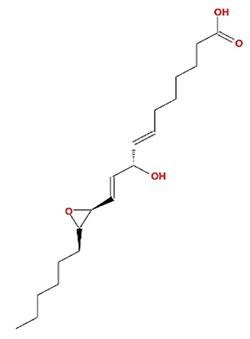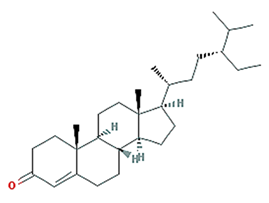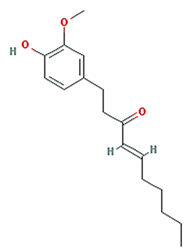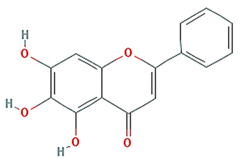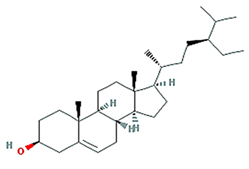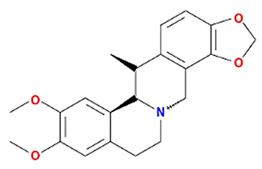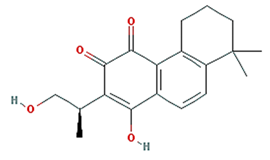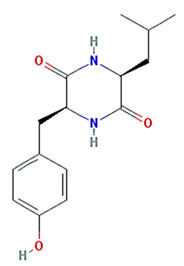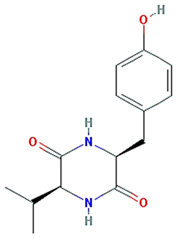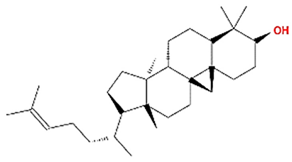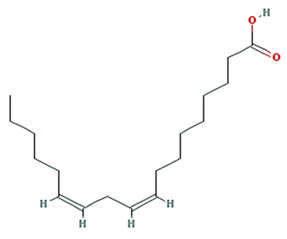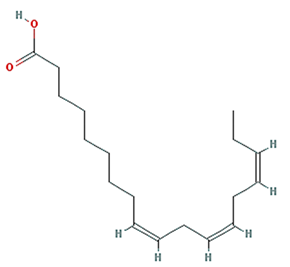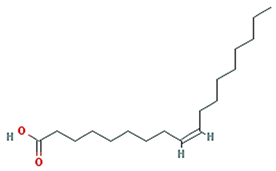Abstract
Pinellia ternata Breitenbach (PTB) is a widely used herbal medicine in China, Japan, and South Korea. It has antiemetic, anti-inflammatory, antitussive, and sedative properties. The raw material is toxic, but can be made safer using alum solution or by boiling it for a long time. In addition, PTB seems to be effective for gastrointestinal motility disorders (GMDs), but this is yet to be conclusively proven. Herein, PTB compounds, targets, and related diseases were investigated using the traditional Chinese medical systems pharmacology database and an analysis platform. Information on target genes was confirmed using the UniProt database. Using Cytoscape 3.8.2, a network was established and GMD-related genes were searched using the Cytoscape stringApp. The effects of the PTB extract on the pacemaker potential of interstitial cells of Cajal and GMD mouse models were investigated. In total, 12 compounds were found to target 13 GMD-related genes. In animal experiments, PTB was found to better regulate pacemaker potential in vitro and inhibit GMD signs compared to control groups in vivo. Animal studies showed that the mechanism underlying the effects of PTB is closely related to gastrointestinal motility. The results obtained demonstrated that PTB offers a potential means to treat GMDs, and we suggested that the medicinal mechanism of GMDs can be explained by the relationship between 12 major components of PTB, including oleic acid, and 13 GMD-related genes.
1. Introduction
Gastrointestinal motility disorders (GMDs) can occur anywhere in the gastrointestinal tract. Therefore, such conditions can exhibit a variety of chronic symptoms that significantly affect a patient’s quality of life, including nausea and vomiting [,,]. Currently, there is no cure for GMD, and management may involve lifestyle changes and drugs. The gastrointestinal process occurs in each segment of this organ, and the contents move between each segment through active and passive peristaltic movements, which are slow waves of muscle contraction and relaxation [,]. Smooth muscle cells, intestinal neurons, including telosites, and interstitial cells of Cajal (ICCs) play an important role in gastrointestinal motility. Various studies have shown that ICCs act as special gastrointestinal pacemaker cells [,]. Thus, abnormalities in ICCs are related to several GMDs such as gastroparesis [].
Pinellia ternata Breitenbach (PTB) is one of the main ingredients in traditional herbal medicine and has been used for antiemetic, antitussive, anti-inflammatory, and sedative purposes since ancient times []. Previously characterized phytochemicals in this herb include alkaloids [], volatile oils [], and polysaccharides []. To investigate the effects of PTB on GMDs and the medicinal mechanisms, we used a network-based system pharmacological approach. We used the traditional Chinese medicine systems pharmacology database and analysis platform (TCMSP, https://tcmsp-e.com/tcmsp.php. accessed date: 10 January 2022 to 15 March 2022), which provides comprehensive information on the relationship between herbs and their components, molecular targets, and diseases. TCMSP provides information on the absorption, distribution, metabolism, and excretion (ADME), which is useful for developing new drugs or analyzing the efficacy of herbal medicines []. A schematic of the research protocol is shown in Figure 1. In this study, a network-based pharmacological analysis of PTB was performed. In addition, PTB extracts were examined for their pacemaking activity and evaluated for their therapeutic effects in mouse models of GMDs.
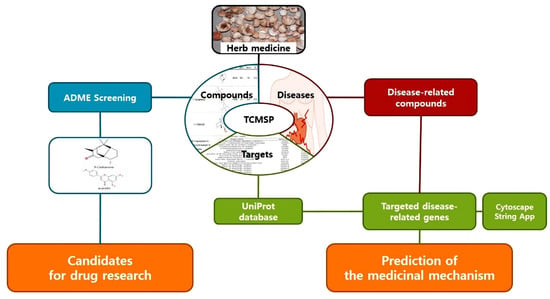
Figure 1.
Schematic of the study protocol for network pharmacology exploration. ADME: absorption, distribution, metabolism, and excretion.
2. Results
2.1. Information for 366 Targets Derived through Correlation Investigation between Compounds and Targets
We identified 116 potentially active compounds in PTB using the TCMSP database (Supplementary Materials Table S1). Among these, 85 compounds contained the target information (Supplementary Materials Table S2), and it was found that these 85 compounds and 366 targets interacted with each other through a combination of 1226 compounds (Figure 2). As shown in Figure 2, GLY was linked to the most target genes (161 genes), followed by DAL (65 genes), succinic acid (57 genes), L-serine (54 genes), ASI (47 genes), oleic acid (43 genes), beta-sitosterol (38 genes), baicalein (36 genes), D-2-aminobutyrate (34 genes), threonine (30 genes), stigmasterol (30 genes), and glutamine (29 genes).
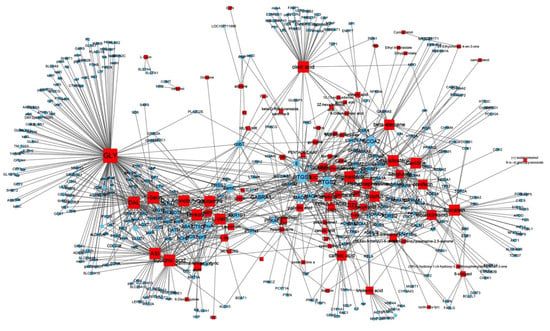
Figure 2.
Compound–target network of Pinellia ternate Breitenbach. The size of the node depends on the number of connected edges. The compounds are expressed as red square nodes, and the targets are expressed as blue round nodes.
2.2. Twenty Active Compounds Met the Criteria for ADME Parameters
Twenty compounds were included in the active compound screening criteria (Table 1) as follows: EIC, (3S,6S)-3-(benzyl)-6-(4-hydroxybenzyl)piperazine-2,5-quinone, 10,13-eicosadienoic acid, 12,13-epoxy-9-hydroxynonadeca-7,10-dienoic acid, 24-ethylcholest-4-en-3-one, 6-shogaol, 8-octadecenoic acid, baicalein, beta-sitosterol, cavidine, coniferin, cyclo-(leu-tyr), cyclo-(val-tyr), cycloartenol, gondoic acid, linolenic acid, methyl palmitelaidate, oleic acid, pedatisectine a, and stigmasterol.

Table 1.
Active compounds of Pinellia ternate Breitenbach.
2.3. Identification of 53 Compounds Related to Gastrointestinal (GI) Disease in PTB
We also investigated the compound–target–disease relationship using the TCMSP database. We found that 53 compounds were associated with GI diseases (Table 2). In particular, EIC, 6-shogaol, cavidine, baicalein, beta-sitosterol, methyl palmitelaidate, (3S,6S)-3-(benzyl)-6-(4-hydroxybenzyl)piperazine-2,5-quinone, linolenic acid, stigmasterol, coniferin, oleic acid, pedatisectine a, and cyclo-(val-tyr) were found to be active compounds associated with GI, and other compounds, including 3,4,5-trihydroxybenzoic acid, ANN, ASI, beta-D-ribofuranoside, xanthine-9, beta-elemene, caffeic acid, cis-p-coumarate, crysophanol, D-2-aminobutyrate, DAL, DTY, DUR, eciphin, ferulic acid (CIS), GLY, gamma-aminobutyric acid, glutamine, OMD, gynesine, HMF, hydroquinone, isolariciresino, istidina, L-arginine, leucinum, L-Ile, L-valine, L-pseudoephedrine, norharman, palmitic acid, pedatisectine f, pentadecylic acid, protocatechuic acid, sitogluside, stearic acid, succinic acid, threonine, THM, vanillic acid, and zoomaric acid, associated with gastrointestinal diseases, were classified as not active (Figure 3).

Table 2.
Compounds and targets related to gastrointestinal (GI) disease.
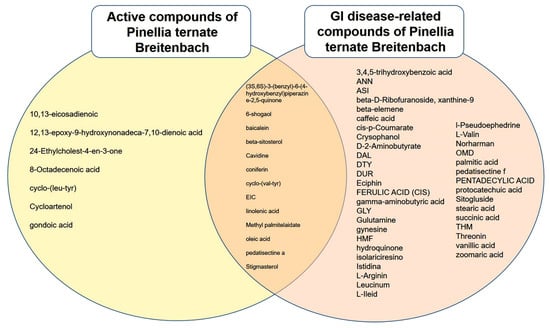
Figure 3.
Venn diagram of the interactions between active compounds and gastrointestinal (GI) disease-related compounds in Pinellia ternate Breitenbach.
2.4. All 52 GI Disease-Related Compounds, Except 6-Shogaolin, in PTB Are Related to GMDs
To determine the relationship between PTB and GMDs, we used the Cytoscaping app to check for GMD-related genetic information. First, 100 GMD-related genes were identified by applying a reliability (score) cutoff of 0.40 and a maximum of 100 proteins (Supplementary Materials Table S3). From the results obtained, a network of GMD-related genes and PTB target genes was created (Figure 4). It was confirmed that there were 13 genes corresponding to both sets of genes. The GMD-related genes targeted by PTB were actin, cytoplasmic 1 (ACTB), cholecystokinin (CCK), C-reactive protein (CRP), proto-oncogene c-Fos (FOS), glucagon (GCG), insulin (INS), myeloperoxidase (MPO), Mu-type opioid receptor (OPRM1), prostaglandin G/H synthase 2 (PTGS2), peptide YY (PYY), sodium channel protein type 5 subunit alpha (SCN5A), sodium-dependent serotonin transporter (SLC6A4), and transient receptor potential cation channel subfamily V member 1 (TRPV1).
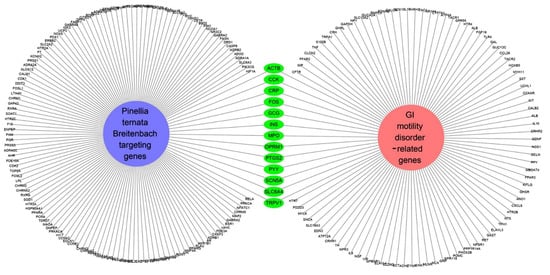
Figure 4.
Network of gastrointestinal motility disorder-related genes and Pinellia ternate Breitenbach-targeting genes. The 13 genes included in both “genes related to gastrointestinal motility disorder” and “Pinellia ternate Breitenbach-target genes” are collected in the center.
2.5. The Network of GMD-Related Genes and Compounds for Identifying Molecules of Interest
Figure 5 illustrates the network of relationships between PTB compounds and GMD-related target genes. The results showed that oleic acid and PTGS2 are most closely related to GMD. In summary, EIC, 6-shogaol, cavidine, baicalein, beta-sitosterol, methyl palmitelaidate, (3S,6S)-3-(benzyl)-6-(4-hydroxybenzyl)piperazine-2,5-quinone, linolenic acid, stigmasterol, coniferin, oleic acid, pedatisectine a, and cyclo-(val-tyr) were determined to be active compounds that target GMD-related genes, indicating that these compounds might be potential medicinal candidates. However, as shown in Figure 2, PTB contained many compounds with multi-targeting characteristics; thus, the synergistic effects of PTB compounds on GMD were investigated in vitro and in vivo.
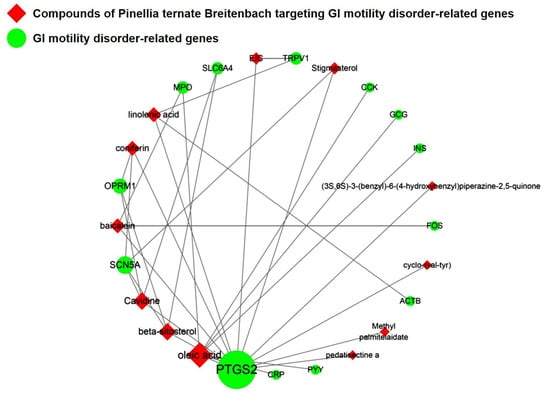
Figure 5.
Network of compounds of Pinellia ternate Breitenbach and gastrointestinal (GI) motility disorder-related genes.
2.6. Effects of PTB Extract on the Pacemaker Potential of ICCs
ICCs regulate gastrointestinal motility by acting as pacemakers in the GI tract [,,]. The whole-cell technique showed that ICCs spontaneously induced pacemaker potentials with an average resting membrane potential of −56.8 ± 1.6 mV and amplitude of 24.9 ± 1.2 mV (Figure 6). PTB extract (10–300 μg/mL) depolarized pacemaker potentials and decreased the amplitude (Figure 6A–D). The average depolarization was 6.9 ± 0.9 mV (p < 0.0001) at 10 μg/mL, 11.2 ± 1.0 mV (p < 0.0001) at 50 μg/mL, 24.8 ± 1.2 mV (p < 0.0001) at 100 μg/mL, and 31.8 ± 1.1 mV (p < 0.0001) at 300 μg/mL (Figure 6E). The average amplitude was 24.2 ± 0.8 mV at 10 μg/mL, 9.8 ± 1.2 mV (p < 0.0001) at 50 μg/mL, 2.9 ± 1.0 mV (p < 0.0001) at 100 μg/mL, and 1.5 ± 0.5 mV (p < 0.0001) at 300 μg/mL (Figure 6F). These results indicated that PTB extract regulates the pacemaker potential of ICCs.

Figure 6.
Effects of PTB extract on pacemaker potential of interstitial cells of Cajal (ICCs). (A–D) PTB extract depolarized the ICC pacemaker potentials. (E,F) The changes in pacemaker potential and amplitude induced by PTB extract are summarized. Means ± SEs. **** p < 0.0001. PTB: Pinellia ternate Breitenbach. CTRL: control.
2.7. Importance of Ca2+ in PTB Extract-Induced Pacemaker Potential Depolarization of ICCs
To investigate the importance of Ca2+ in PTB extract-induced responses, we used external Ca2+-free conditions or thapsigargin. Pre-treatment with an external Ca2+-free solution or thapsigargin suppressed pacemaker potentials and inhibited PTB extract-induced responses (Figure 7A,B). The average depolarization was 1.1 ± 0.5 mV (p < 0.0001) with Ca2+-free solution and 1.2 ± 0.3 mV (p < 0.0001) with thapsigargin (Figure 7C). However, the average amplitude did not change significantly (Figure 7D). These results indicated that the PTB extract-induced responses are controlled by Ca2+.
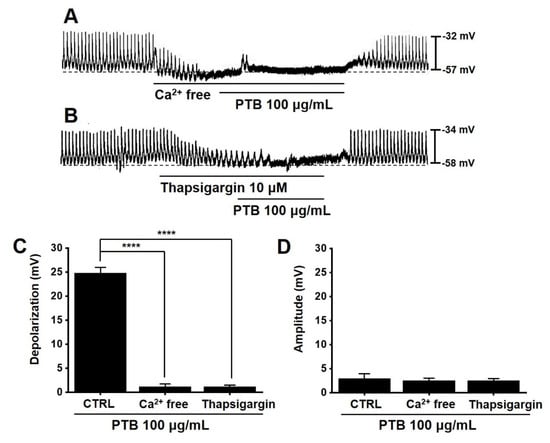
Figure 7.
Effects of Ca2+ on PTB extract-induced pacemaker potential depolarization. (A) For external Ca2+-free solution, PTB extract did not result in depolarization. (B) With thapsigargin, PTB extract also did not result in depolarization. (C,D) Depolarization and amplitude responses to PTB extract are summarized. Means ± SEs. **** p < 0.0001. PTB: Pinellia ternate Breitenbach. CTRL: control.
2.8. Importance of Muscarinic M3, 5-HT3, and 5-HT7 Receptors in PTB Extract-Induced Pacemaker Potential Depolarization of ICCs
Muscarinic and 5-HT receptors are expressed in the GI tract and associated with gastrointestinal motility [,]. Murine small intestinal ICCs express muscarinic M2, M3, or 5-HT3,4,7 receptors [,]. Pre-treatment with 4-DAMP (a muscarinic M3 receptor antagonist) inhibited the PTB-induced effects (Figure 8A). However, methoctramine, (a muscarinic M2 receptor antagonist) had no effect (Figure 8B). In addition, Y25130 (a 5-HT3 antagonist) and SB269970 (a 5-HT7 antagonist) inhibited PTB-induced effects (Figure 8C,E). However, RS39604 (a 5-HT4 antagonist) showed no effect (Figure 8D). The average depolarization was 6.9 ± 0.8 mV (p < 0.0001) with 4-DAMP, 25.6 ± 1.2 mV with methoctramine, 6.1 ± 0.7 mV (p < 0.0001) with Y25130, 23.6 ± 1.2 mV with RS39604, and 6.0 ± 0.9 mV (p < 0.0001) with SB269970 (Figure 8F). The average amplitude was 13.5 ± 0.7 mV (p < 0.0001) with 4-DAMP, 3.5 ± 1.1 mV with methoctramine, 14.2 ± 0.4 mV (p < 0.0001) with Y25130, 4.2 ± 0.9 mV with RS39604, and 14.2 ± 0.8 mV (p < 0.0001) with SB269970 (Figure 8G). These results suggested that PTB affects pacemaker potentials via the M3, 5-HT3, and 5-HT7 receptors.
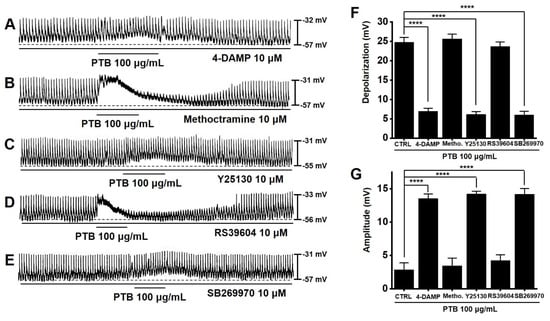
Figure 8.
Effects of muscarinic and 5-HT receptor antagonists on PTB extract-induced pacemaker potential depolarization. (A) Pre-treatment with 4-DAMP inhibited PTB extract-induced effects. (B) Pre-treatment with methoctramine had no effects on PTB extract-induced effects. (C,E) Pre-treatment with Y25130 or SB269970 inhibited PTB extract-induced effects. (D) Pre-treatment with RS39604 had no effects on PTB extract-induced effects. (F,G) Depolarization and amplitude responses to PTB extract are summarized. Means ± SEs. **** p < 0.0001. PTB: Pinellia ternate Breitenbach. CTRL: control. Metho.: methoctramine.
2.9. Effects of PTB Extract on the ITR
The ITR was 51.0 ± 3.2% (Figure 5). The PTB extract increased the ITR to 50.1 ± 3.2% at 0.01 g/kg, 58.9 ± 6.3% at 0.1 g/kg, and 76.1 ± 6.1% (p < 0.0001) at 1 g/kg (Figure 9A). In addition, AA decreased ITR (32.5 ± 4.2% vs. 50.3 ± 2.6% in normal mice; P < 0.0001; Figure 9B). However, PTB extract restored this response to 52.5 ± 1.7% (p < 0.0001), 51.3 ± 3.8% (p < 0.0001), and 56.8 ± 1.9% (p < 0.0001), respectively (Figure 9B). These results indicated that the PTB extract can increase the normal ITR and recover the ITR in GMD mice.

Figure 9.
Effects of PTB extract on the intestinal transit rate (ITR) in normal and gastrointestinal motility disorder (GMD) mice. (A) PTB extract increased the ITR. (B) The ITR was recovered by PTB extract in GMD mice. Means ± SEs. * p < 0.05. *** p < 0.001. **** p < 0.0001. PTB: Pinellia ternate Breitenbach. CTRL: control.
3. Discussion
PTB is a monocotyledonous perennial herbaceous plant that is widely used in traditional herbal medicine in China, Japan, and South Korea. It has been used for antiemetic, anti-inflammatory, antitussive, and sedative purposes []. In addition, experiments using a mouse model have shown that PTB induces efferent activity in the gastric branches of the vagus nerve, which is known to be effective in GMDs, but the pharmacological mechanisms underlying this have yet to be studied []. Therefore, this study was conducted using a combination of network-based pharmacological analyses and experimental verification to identify the physiologically active ingredients and medicinal mechanisms of PTB. Additionally, 116 compounds were identified in PTB, including 19 active compounds (Sup. 1). Of these 116 compounds, 85 had target information and 365 target genes were collected (Sup. 2). Twelve genes were associated with GMD (Figure 5), including ACTB, CCK, CRP), FOS, GCG, INS, MPO, OPRM1, PTGS2, PYY, SCN5A, SLC6A4, and TRPV1 (Figure 4). These results are the same as those of past studies. Specifically, as shown in Table 2 and Figure 5, PTGS2 was the target of all GMD-related PTB compounds, suggesting that PTB compounds can adjust PTGS2 levels synergistically. PTGS2 plays the most important role in the treatment of mucosal defense and gastrointestinal inflammation and ulcers. PTGS2 also contributes to normalization of gastrointestinal function after inflammation []. In addition, SCN5A and OPRM1 were found to be targets of multiple PTB compounds. The voltage-gated mechanosensitive Na+ channel NaV1.5, encoded by SCN5A, is present in ICCs and human gastrointestinal smooth muscle cells. SCN5A contributes to the electrical slow wave and mechanical sensitivity of smooth muscles []. OPRM1 is linked to the inhibition of acetylcholine release from intestinal and motor neurons and the inhibition of purine and nitrogen release from motor neurons, thereby inhibiting propulsion kinetic patterns []. OPRM1 activation induces the inhibition of submucosal secretion by motor neurons, which reduces active Cl secretion and passive liquid movement to the colon lumen []. This effect on mobility and secretion results in constipation induced by OPRM1. These results indicate that the medicinal mechanism of GMDs is related to the effects of PTB on PTGS2, SCN5A, and ORPM1. The GMD-related active compounds EIC, (3S,6S)-3-(benzyl)-6-(4-hydroxybenzyl)piperazine-2,5-quinone, baicalein, beta-sitosterol, cavidine, coniferin, cyclo-(val-tyr), linolenic acid, methyl palmitelaidate, oleic acid, pedatisectine a, and stigmasterol were identified (Figure 5). In addition, 12 compounds were found to target PTGS2, and oleic acid was found to target PTGS2, MPO, CCK, CRP, GCG, INS, and PYY. Beta-sitosterol targets PTGS2, SCN5A, OPRM1, and SLC6A4, and cavidine targets PTGS2, SCN5A, OPRM1, and SLC6A4. Several studies have reported a relationship between the major components of PTB and GMDs. Emulsions containing oleic acid activate nutrient-induced inhibitory feedback mechanisms in the small intestine, slowing down gastrointestinal passage and reducing diarrhea []. beta-sitosterol has significant antibacterial activity and improved DSS-induced colitis in mice []. Cavidine improved ulcerative colitis by regulating the oxidation and antioxidant balance and inhibiting NF-κB signaling pathways and pro-inflammatory cytokines, such as TNF-α and IL-6, in colonic tissue []. As shown in Figure 2, compounds interacted with an average of 14 target genes upon identifying the multi-compound multi-target properties of herbal medicines, and PTB was predicted to be a therapeutic medicine for GMDs based on the synergies among several compounds contained in PTB.
We investigated the restorative effects of PTB in a mouse model of GMDs. First, we checked the effects of PTB extract on the pacemaker potentials of ICCs. PTB extract was found to regulate the pacemaker potential of ICCs, and this response was controlled by Ca2+ (Figure 6 and Figure 7). In addition, PTB reactions occurred through M3, 5-HT3, and 5-HT7 receptors (Figure 8). Further, PTB extract increased the normal ITR and restored the ITR in GMD mice (Figure 9). In summary, our results showed that PTB has potential for the treatment of GMDs, and that its medicinal effect may be due to the regulation of ICCs. They also suggested that these mechanisms are related to the interactions among 12 key components of PTB, such as oleic acid, and 13 GMD-related genes, including PTGS2.
4. Materials and Methods
4.1. Network-Based Pharmacological Analysis by PTB
4.1.1. Identification of PTB Compounds
Analysis platforms were used to identify the potential active compounds of PTB. We entered ‘Pinellia ternata Breitenbach’ as a query to search for the herb name.
4.1.2. Analysis of Targets
The target information of the compound was determined by searching TCMSP []. The target proteins were linked to the official gene names using the UniProtKB database (https://www.uniprot.org/uniprot. accessed date: 10 January 2022 to 15 March 2022) [].
4.1.3. Network Analysis
The compound–target network was constructed using Cytoscape 3.8.2 (https://cytoscape.org. accessed date: 10 January 2022 to 15 March 2022) []. GMD-related genes were collected using the Cytoscaping app [].
4.1.4. Active Compound Screening
Using ADME parameters such as molecular weight, oral bioavailability (OB), Caco-2 permeability (Caco-2), and drug likeness (DL), physiologically active compounds in PTB were screened using the following criteria: OB ≥ 30%, DL ≥ 0.10, and Caco −2 ≥ −0.4. Compounds with values that met the criteria applied were considered active compounds.
4.2. Animal Experiments
4.2.1. Preparation of the PTB Extract
Dried PTB was purchased from Herb Farm Co. (Wonju, Korea). A voucher specimen (PJW-058) was deposited at the Department of Herbology, College of Korean Medicine, Kyung Hee University, Korea. Dried PTB (400 g) was extracted using distilled water (4000 mL) for 2 h at 100 °C. The water extract of PTB was passed through a membrane filter (0.45 μm; EMD Millipore). After evaporation, the remaining aqueous extract was freeze-dried to yield 8.5% of the dried weight (w/w).
4.2.2. Preparation of ICCs
A total of 74 ICR mice (37 males and 37 females; 3–8 days-old) were used for the experiments. Small intestinal cells were cultured with smooth muscle growth medium (Clonetics, San Diego, CA, USA).
4.2.3. Electrophysiological Experiments
KCl 5 mM, NaCl 135 mM, CaCl2 2 mM, glucose 10 mM, MgCl2 1.2 mM, and HEPES 10 mM were used as bath solutions. KCl 140 mM, MgCl2 5 mM, K2ATP 2.7 mM, NaGTP 0.1 mM, creatine phosphate disodium 2.5 mM, HEPES 5 mM, and EGTA 0.1 mM were used as pipette solutions. Whole-cell configuration was used.
4.2.4. Intestinal Transit Rate (ITR)
A total of 45 ICR mice (males, 5–6 weeks-old) were used for ITR experiments. Evans blue (5%, w/v) was administered after the administration of PTB extract into the stomach. After 30 min of Evans blue administration, the ITR was measured.
4.2.5. GMD Model Mice
Acetic acid (AA, 0.6%, w/v, in saline)-induced peritoneal stimulation was used to generate a GMD mouse model. AA was injected intraperitoneally, and other processes were the same as previous studies [,].
4.2.6. Statistical Analyses
Data are expressed as the mean ± standard error of the mean. Significant differences were evaluated using one-way analysis of variance or a student’s t-test. Statistical significance was considered as p < 0.05.
5. Conclusions
PTB analysis using a network-based pharmacological approach showed that 12 compounds and 13 genes were associated with GMDs. Our animal studies showed that PTB regulates the pacemaker potential of ICCs and inhibits GMD-like signs in a mouse model of GMDs. These results indicate that PTB has therapeutic potential for GMD treatment. In addition, we proposed a mechanism responsible for the interactions among 12 PTB compounds and 13 GMD-related genes.
Supplementary Materials
The following supporting information can be downloaded at: https://www.mdpi.com/article/10.3390/plants11101348/s1, Table Supplemantary Materials Table S1: Potential active compounds of Pinellia ternata Breitenbach. Table Supplemantary Materials Table S2: Target genes of Pinellia ternata Breitenbach. Table Supplemantary Materials Table S3: One hundred gastrointestinal motility disorder-related genes.
Author Contributions
Context conceptualization, J.-W.P. and B.J.K.; methodology, N.R.C., J.P., S.-J.K. and J.N.K.; software, N.R.C., J.N.K. and S.-J.K.; validation, N.R.C.; formal analysis, N.R.C.; investigation, N.R.C., J.P., S.-J.K. and J.N.K.; resources, N.R.C.; data curation, N.R.C., J.P., S.-J.K., J.N.K. and W.C.; writing—original draft preparation, N.R.C., J.P., S.-J.K. and W.C.; writing—review and editing, J.-W.P. and B.J.K.; supervision, J.-W.P. and B.J.K.; project administration, J.P., J.-W.P. and B.J.K. All authors have read and agreed to the published version of the manuscript.
Funding
This study was supported by Basic Science Research Program through the National Research Foundation of Korea (NRF) funded by the Ministry of Education (2021R1I1A3042479).
Institutional Review Board Statement
The animal study protocol was approved by the Institutional Animal Care and Use Committee (IACUC) at Pusan National University (Busan, Korea; approval no. PNU-2020-2831).
Informed Consent Statement
Not applicable.
Data Availability Statement
The datasets used and/or analyzed during the current study are available from the corresponding author upon reasonable request.
Conflicts of Interest
The authors declare no conflict of interest.
References
- Gralnek, I.M.; Hays, R.D.; Kilbourne, A.; Naliboff, B.; Mayer, E.A. The impact of irritable bowel syndrome on health-related quality of life. Gastroenterology 2000, 119, 654–660. [Google Scholar] [CrossRef] [PubMed]
- Pare, P.; Ferrazzi, S.; Thompson, W.G.; Irvine, E.J.; Rance, L. An epidemiological survey of constipation in canada: Definitions, rates, demographics, and predictors of health care seeking. Am. J. Gastroenterol. 2001, 96, 3130–3137. [Google Scholar] [CrossRef] [PubMed]
- El-Serag, H.B.; Talley, N.J. Health-related quality of life in functional dyspepsia. Aliment. Pharmacol. Ther. 2003, 18, 387–393. [Google Scholar] [CrossRef] [PubMed]
- Huizinga, J.D. Gastrointestinal peristalsis: Joint action of enteric nerves, smooth muscle, and interstitial cells of Cajal. Microsc. Res. Tech. 1999, 47, 239–247. [Google Scholar] [CrossRef]
- Huizinga, J.D.; Lammers, W.J. Gut peristalsis is governed by a multitude of cooperating mechanisms. Am. J. Physiol. Gastrointest. Liver Physiol. 2009, 296, G1–G8. [Google Scholar] [CrossRef] [PubMed]
- Blair, P.J.; Rhee, P.L.; Sanders, K.M.; Ward, S.M. The significance of interstitial cells in neurogastroenterology. J. Neurogastroenterol. Motil. 2014, 20, 294–317. [Google Scholar] [CrossRef]
- Sanders, K.M.; Ward, S.M.; Koh, S.D. Interstitial cells: Regulators of smooth muscle function. Physiol. Rev. 2014, 94, 859–907. [Google Scholar] [CrossRef]
- Streutker, C.J.; Huizinga, J.D.; Driman, D.K.; Riddell, R.H. Interstitial cells of Cajal in health and disease. Part I: Normal ICC structure and function with associated motility disorders. Histopathology 2007, 50, 176–189. [Google Scholar] [CrossRef]
- Maki, T.; Takahashi, K.; Shibata, S. An anti-emetic principle of Pinellia ternata tuber. Planta Med. 1987, 53, 410–414. [Google Scholar] [CrossRef]
- Zhao, L.; Su, X. Comparative analysis of alkaloid components in cultured and planted Pinellia ternata (Thunb.) Breit. China J. Chin. Med. 1990, 15, 146–190. [Google Scholar]
- Wang, R.; Ni, J.M.; Ma, R. Volatile oils of Pinellia ternate. J. Chin. Pharm. 1995, 30, 457–459. [Google Scholar]
- Gonda, R.; Tomoda, M.; Shimizu, N.; Ohara, N.; Takagi, H.; Hoshino, S. Characterization of an acidic polysaccharide with immunological activities from the tuber of Pinellia ternata. Biol. Pharm. Bull. 1994, 17, 1549–1553. [Google Scholar] [CrossRef] [PubMed] [Green Version]
- Ru, J.; Li, P.; Wang, J.; Zhou, W.; Li, B.; Huang, C.; Li, P.; Guo, Z.; Tao, W.; Yang, Y.; et al. TCMSP: A database of systems pharmacology for drug discovery from herbal medicines. J. Cheminform. 2014, 6, 13. [Google Scholar] [CrossRef] [PubMed] [Green Version]
- Ehlert, F.J.; Pak, K.J.; Griffin, M.T. Muscarinic agonists and antagonists: Effects on gastrointestinal function. Handb. Exp. Pharmacol. 2012, 208, 343–374. [Google Scholar]
- Mawe, G.M.; Hoffman, J.M. Serotonin Signaling in the Gastrointestinal Tract: Functions, dysfunctions, and therapeutic targets. Nat. Rev. Gastroenterol. Hepatol. 2013, 10, 473–486. [Google Scholar] [CrossRef] [Green Version]
- Liu, H.N.; Ohya, S.; Nishizawa, Y.; Sawamura, K.; Iino, S.; Syed, M.M.; Goto, K.; Imaizumi, Y.; Nakayama, S. Serotonin augments gut pacemaker activity via 5-HT3 receptors. PLoS ONE 2011, 6, e24928. [Google Scholar] [CrossRef] [Green Version]
- Lino, S.; Horiguchi, K. Interstitial Cells of Cajal Are Involved in Neurotransmission in the Gastrointestinal Tract. Acta. Histochem. Cytochem. 2006, 39, 145–153. [Google Scholar]
- Chen, J.H.; Cui, G.Y.; Liu, J.Y.; Tan, R.X. Pinelloside, an antimicrobial cerebroside from Pinellia ternata. Phytochemistry 2003, 64, 903–906. [Google Scholar] [CrossRef]
- Niijima, A.; Okui, Y.; Kubo, M.; Higuchi, M.; Taguchi, H.; Mitsuhashi, H.; Maruno, M. Effect of Pinellia ternata tuber on the efferent activity of the gastric vagus nerve in the rat. Brain Res. Bull. 1993, 32, 103–106. [Google Scholar] [CrossRef]
- Wallace, J.L.; Devchand, P.R. Emerging roles for cyclooxygenase-2 in gastrointestinal mucosal defense. Br. J. Pharmacol. 2005, 145, 275–282. [Google Scholar] [CrossRef] [Green Version]
- Strege, P.R.; Mazzone, A.; Bernard, C.E.; Neshatian, L.; Gibbons, S.J.; Saito, Y.A.; Tester, D.J.; Calvert, M.L.; Mayer, E.A.; Chang, L.; et al. Irritable bowel syndrome patients have SCN5A channelopathies that lead to decreased NaV1.5 current and mechanosensitivity. Am. J. Physiol. Gastrointest. Liver Physiol. 2018, 314, G494–G503. [Google Scholar] [CrossRef] [PubMed] [Green Version]
- Galligan, J.J.; Sternini, C. Insights into the Role of Opioid Receptors in the GI Tract: Experimental Evidence and Therapeutic Relevance. Handb. Exp. Pharmacol. 2017, 239, 363–378. [Google Scholar] [PubMed]
- Kopic, S.; Corradini, S.; Sidani, S.; Murek, M.; Vardanyan, A.; Föller, M.; Ritter, M.; Geibel, J.P. Ethanol inhibits gastric acid secretion in rats through increased AMP-kinase activity. Cell. Physiol. Biochem. 2010, 25, 195–202. [Google Scholar] [CrossRef] [PubMed]
- Lin, H.C.; van Citters, G.W.; Heimer, F.; Bonorris, G. Slowing of gastrointestinal transit by oleic acid: A preliminary report of a novel, nutrient-based treatment in humans. Dig. Dis. Sci. 2001, 46, 223–229. [Google Scholar] [CrossRef]
- Ding, K.; Tan, Y.Y.; Ding, Y.; Fang, Y.; Yang, X.; Fang, J.; Xu, D.C.; Zhang, H.; Lu, W.; Li, M.; et al. β-Sitosterol improves experimental colitis in mice with a target against pathogenic bacteria. J. Cell. Biochem. 2019, 120, 5687–5694. [Google Scholar] [CrossRef] [PubMed]
- Niu, X.; Zhang, H.; Li, W.; Wang, Y.; Mu, Q.; Wang, X.; He, Z.; Yao, H. Protective effect of cavidine on acetic acid-induced murine colitis via regulating antioxidant, cytokine profile and NF-κB signal transduction pathways. Chem. Biol. Interact. 2015, 239, 34–45. [Google Scholar] [CrossRef] [PubMed]
- UniProt Consortium. UniProt: A worldwide hub of protein knowledge. Nucleic Acids Res. 2019, 47, D506–D515. [Google Scholar] [CrossRef] [Green Version]
- Shannon, P.; Markiel, A.; Ozier, O.; Baliga, N.S.; Wang, J.T.; Ramage, D.; Amin, N.; Schwikowski, B.; Ideker, T. Cytoscape: A software environment for integrated models of biomolecular interaction networks. Genome Res. 2003, 13, 2498–2504. [Google Scholar] [CrossRef]
- Doncheva, N.T.; Morris, J.H.; Gorodkin, J.; Jensen, L.J. Cytoscape StringApp: Network Analysis and Visualization of Proteomics Data. J. Proteome Res. 2019, 18, 623–632. [Google Scholar] [CrossRef]
- Kim, B.J.; Kim, H.W.; Lee, G.S.; Choi, S.; Jun, J.Y.; So, I.; Kim, S.J. Poncirus trifoliate fruit modulates pacemaker activity in interstitial cells of Cajal from the murine small intestine. J. Ethnopharmacol. 2013, 149, 668–675. [Google Scholar] [CrossRef]
- Wu, Y.S.; Lu, H.L.; Huang, X.; Liu, D.H.; Meng, X.M.; Guo, X.; Kim, Y.C.; Xu, W.X. Diabetes-induced loss of gastric ICC accompanied by up-regulation of natriuretic peptide signaling pathways in STZ-induced diabetic mice. Peptides 2013, 40, 104–111. [Google Scholar] [CrossRef] [PubMed]
Publisher’s Note: MDPI stays neutral with regard to jurisdictional claims in published maps and institutional affiliations. |
© 2022 by the authors. Licensee MDPI, Basel, Switzerland. This article is an open access article distributed under the terms and conditions of the Creative Commons Attribution (CC BY) license (https://creativecommons.org/licenses/by/4.0/).
